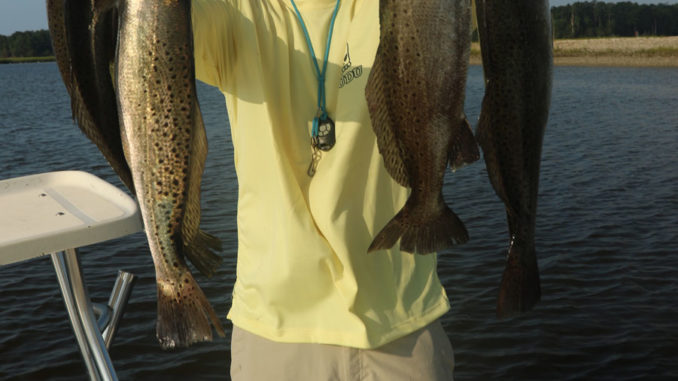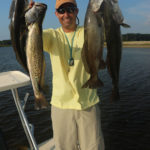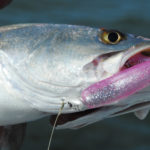
October artificials are often more-productive
Ask any saltwater angler in South Carolina to choose his or her favorite fishing month, and a good many will tell you October is the one they look forward to all year. No matter what your favorite fish is, the chance of catching good numbers are high this month. The influx of shrimp and baitfish, the cooling of the water and air and the seasonal migration of fish between offshore, nearshore and inshore combine to give anglers some of the hottest saltwater action they’ll see.
With an abundance of baitfish and shrimp available, some anglers believe live bait is the best option for catching big numbers of fish, but guides like Stephen Fields of Charleston Fishing Company and Rick Percy of Beaufort’s Reel Chance Charters say using artificial lures is the way to go in October.
Percy said this month is a favorite of his for catching speckled trout on artificials like VuDu shrimp, Norton Sand Eels, and MirrOLure SheDog surface lures.
“You’ll definitely catch fish on live bait this month, but I guarantee that on any given day, you’ll catch more fish on artificial lures than you will on natural bait,” he said.
The reason, according to Percy, is because the action is often so fast that anglers who take the time to rebait their hook after every fish are missing out on bites.
“When you catch a fish on a VuDu shrimp, you unhook the fish, and cast immediately back to the hole. You catch a fish on a live shrimp, and you have to unhook the fish, reach in the bait well, pull out a shrimp, thread your hook through it, then cast. Another angler using plastic shrimp has already caught another fish by then,” he said.
When a fish strikes but misses the hook, that often still results in a half-eaten shrimp that is far less likely to entice a bite than any plastic lure, which stands up better to strikes than live bait.
Percy (803-535-6166) said fishing a soft-plastic shrimp under a popping cork is one of the most- consistent ways to catch trout this month, and the best place to cast is anywhere you see a current break. This is especially effective on an incoming tide around oyster shell banks. At high tide, it’s still a good strategy as long as a noticeable current break is present, but it’s also a good time to fish these lures and Norton Sand Eels without a cork. Casting them into deeper water and letting them sink slowly without imparting any action on them is a good tactic. Trout will often hit them while falling, and when that doesn’t happen, anglers can sometimes entice a bite by retrieving the lures with a quick twitch, a long pause, then another quick twitch.
For the most-exciting bite of the fall, Percy said you can’t beat topwater lures at daybreak. “Walk-the-dog” type baits like Super Spooks and MirrOLures are unbeatable when fished over oyster rakes in smaller creeks.
Fields feels the same way about using artificial lures for redfish this month. LIVETARGET’s Bait Ball Yearling walking lures are good bets on a high, falling or mid-incoming tide.
“This time of year, the redfish are starting to school up, and these lures work well where the schools are on the flats,” said Fields (843-412-6811), who likes to cast parallel to the bank and retrieve the lures with the twitch-pause-twitch-pause pattern. Then, he’ll anchor down with his Talon anchor, keeping the redfish schools located between him and the bank.
While this is similar to the way Percy catches trout, Fields said redfish sometimes have a little trouble with the lures.
“It’s not often, but some days, redfish just can’t get their smaller mouths on those topwater baits,” he said.
When that happens, Fields has a solution. He follows up missed topwater bites with a soft-plastic Z-Man PaddlerZ on a swimbait hook.
“If they hit a topwater bait and miss, they will jump on one of these immediately,” Fields said.
These soft-plastic lures are also his go-to choice when fishing at low tide.
“A lot of this is sight-fishing this month, especially at low tide near oyster points, and any place that has two different things meeting, like where shell banks meet grass lines, where drastic water depths occur, or where one current flow runs into another,” Fields said.






Be the first to comment